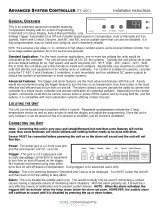
1.8 Safety
WARNING
The voltage of the frequency converter is dangerous
whenever connected to mains. Incorrect installation of
the motor, frequency converter or fieldbus may cause
death, serious personal injury or damage to the
equipment. Consequently, the instructions in this
manual, as well as national and local rules and safety
regulations, must be complied with.
Safety Regulations
•
Disconnect mains supply to the frequency
converter whenever repair work is to be carried
out. Check that the mains supply has been
disconnected and that the necessary time has
elapsed before removing motor and mains supply
plugs.
•
[Off] does not disconnect the mains supply and
consequently, it must not be used as a safety
switch.
•
Ground the equipment properly, protect the user
against supply voltage and protect the motor
against overload in accordance with applicable
national and local regulations.
•
The ground leakage current exceeds 3.5 mA.
•
Protection against motor overload is not included
in the factory setting. If this function is desired,
set 1-90 Motor Thermal Protection to data value [4]
ETR trip 1 or data value [3] ETR warning 1.
•
Do not remove the plugs for the motor and
mains supply while the frequency converter is
connected to mains. Check that the mains supply
has been disconnected and that the necessary
time has elapsed before removing motor and
mains plugs.
•
The frequency converter has more voltage
sources than L1, L2 and L3, when load sharing
(linking of DC intermediate circuit) or external 24
V DC are installed. Check that all voltage sources
have been disconnected and that the necessary
time has elapsed before commencing repair work.
Warning against unintended start
•
The motor can be stopped with digital
commands, bus commands, references or a local
stop, while the frequency converter is connected
to mains. These stop functions are not sufficient
to prevent unintended motor start and thus
prevent personal injury caused by e.g. contact
with moving parts. To consider personal safety,
disconnect the mains supply or activate the Safe
Torque Off function.
•
The motor may start while setting the
parameters. If this compromises personal safety
(e.g. personal injury caused by contact with
moving machine parts), prevent motor starting,
for instance by use of the Safe Torque Off
function or secure disconnection of the motor
connection.
•
A motor that has been stopped with the mains
supply connected may start if faults occur in the
electronics of the frequency converter, through
temporary overload, or if a fault in the power
supply grid or motor connection is remedied. If
unintended start must be prevented for personal
safety reasons (e.g. risk of injury caused by
contact with moving machine parts), the normal
stop functions of the frequency converter are not
sufficient. In such cases, disconnect mains supply
or activate Safe Torque Off.
NOTICE
When using Safe Torque Off, always follow the
instructions in VLT
®
Frequency Converters - Safe Torque
Off Operating Instructions.
•
Control signals from, or internally within, the
frequency converter may in rare cases be
activated in error, be delayed or fail to occur
entirely. When used in situations where safety is
critical, these control signals must not be relied
on exclusively.
Introduction Programming Guide
8 Danfoss A/S © Rev. 2014-04-25 All rights reserved. MG20O802
1
1























